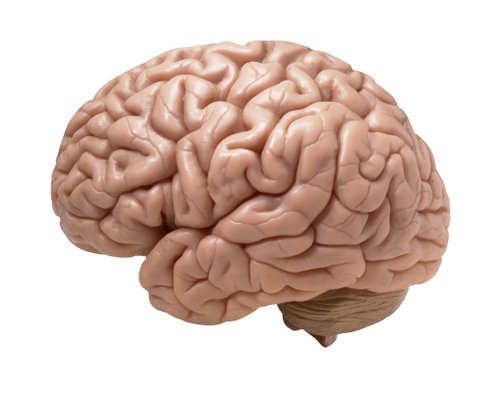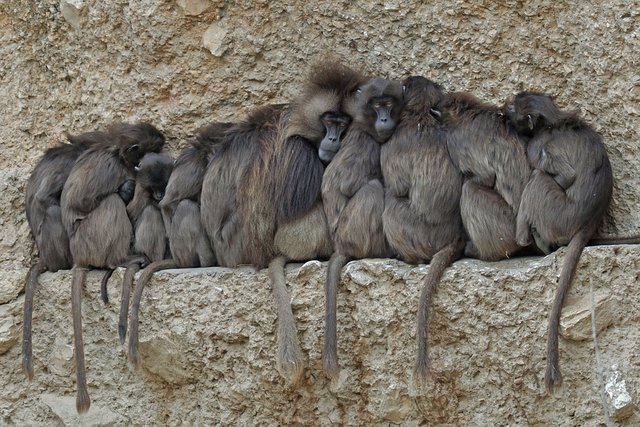The Human Brain. Part One: Evolution

What looks strangely alien, and yet is the most definitively human object we possess? Here is the answer:

The human brain. It’s appearance reminds us of some strange boneless deep sea creature or perhaps a particularly disturbing type of fungus. However it is the biggest point of difference between us and our closest evolutionary relatives. Many other animals are much stronger or faster than us, or have much keener senses. Despite our relatively weak physical abilities this strange object in our heads has allowed us to reach our current dominant status on our planet.
In this series I want to talk about how and why our brains evolved, what makes them special, and go through conclusions and theories about how they work. Now let’s look at a cross-section of the brain.
The majority of the human brain is made up of the cerebral cortex, labelled with a 1 on the diagram. The outer layer of the cerebral cortex is called the neocortex. The neocortex is the most recent part of the brain to develop in evolutionary terms. It sits on top of the older structures, which do not differ too much from other mammals. The neocortex makes possible our higher mental functions, such as language, abstract thought, and ability to learn and adapt. [1] Other parts of the brain also play a part in these functions, but the neocortex does the real heavy lifting, and is the part of the brain we will focus on from here.
Fascinating Facts about the Neocortex
The purpose of the rather unattractive folds and creases is to increase the surface area of the neocortex. If you were to stretch it out flat it would cover approximately the same area as a large dinner napkin. It is only 2 to 4 mm thick.
The complexity of the neocortex is daunting. The average human neocortex contains around 21 billion neurons. Each of those neurons is connected to between 1000 and 10,000 other neurons.
The neocortex doesn’t finish developing until our late 40s. [2]
Evolutionary purpose
As you might expect from an object packed with so many neurons and connections, the brain uses a huge amount of energy. Although it only weighs 1.2-1.4 kilograms, it uses approximately 20% of the energy consumed by the body. The large human brain is a very expensive investment for an evolving human who had to spend a large part of their day running after animals like antelopes and away from animals like the sabertooth tigers of the time.[2] What were the evolutionary pressures that caused humans to develop in this direction? Holekamp KE, Benson-Amram S. 2017 [3]summarise the four main hypotheses.
1. Complexity in the Physical Environment
When food is abundant, animals have little need to adapt or evolve. When food is hard to come by however, animals must move to a new environment, exploit new food sources, or improve at extracting the food available. These pressures can select for mental abilities such as enhanced memory or planning. [4]

2. Complexity in the Social Environment
According to this theory, primates had to evolve large brains to enable them to manage the coordination necessary to live in a large group. In communal living, it helps to remember facts like you are in a relationship with Ulga, while Thog is in a relationship with Pag. If you can’t remember this, and you try to jump on Pag every time you catch sight of her, your group might not stay together long. In Dunbar (1981) [5] it was found that cognitive ability acts as a constraint on group size. Less intelligent primates could not manage the social management necessary to keep a large group together. This rule breaks down when considering other species such as ants, who are clearly able to keep a huge group together despite their extremely low intelligence.
3. Complexity in the Cultural Environment
This theory is an extension of the second. As it became common for primates to live in large groups, individuals with high ability at cognitively demanding skills like planning, strategy, and understanding one’s rivals had an advantage. If Thog can convince you it is in your best interest to go on a dangerous hunting expedition while he ‘watches’ your wife, your genes clearly have a reduced chance of surviving to the next generation. In Byrne and Corp (2004) [6]it was found that primates with a larger neocortex were better at deceiving other individuals.
4. The Cognitive Buffer Theory
The cognitive buffer theory deals with general intelligence. It is not difficult to see how some domain specific intelligence might evolve in accordance with the complexity in the physical environment theory. For example, the need to go on long expeditions to hunt for food could explain the need to develop navigational abilities and a long-term memory. However animals with a large neocortex seem to show a general ability to solve problems and develop new behaviour, even when placed in unfamiliar situations.[3] Therefore the cognitive buffer theory holds that animals in a rapidly changing environment developed more intelligence than they needed for their daily lives, so that they were able to adapt and learn quickly when exposed to something completely new.

Holekamp and Benson (2017)[3] found that even when holding factors such as physical and social environment constant, hyenas with a larger neocortex were able to perform better on problem-solving tasks.
Conclusion
It seems that all of the four theories contributed to some degree to the evolution of the human brain. Our mental abilities cannot be fully explained solely as a reaction to our environment, instead nature seems to have given us tools which we can apply to any situation, real or imagined.
This article looked at some of the basic structures of the brain, and looked at theories of the evolutionary pressures that shaped the abilities that we possess today. In future articles I want to make some comparisons of our brains with other animals, to help to understand what makes us special, and then onto a global theory of how our neocortex operates, and what this may mean for future neuroscience and artificial intelligence.
REFERENCES
Hawkins, J. & Blakesee, S. On Intelligence. (Times Books, New York, 2004)
This post is awesome
I don't know where to start from
Well let me just point out things I learnt
Was really shocked to hear this
Hearing this for the first time but I realize how true it is when I remembered watching about a particular animal which migrated from different locations and it's brain adaptations on natgeowild
Hi Izzrael thanks for reading. Yeah the brain is pretty energy hungry, I also read it could only grow really big once early humans started eating meat, a vegetarian diet doesn’t have enough energy. Another reason to eat my hamburgers!
What are your thoughts on the 'stoned ape' theory? The idea that one thing that lead to the rapid development of our cognitive capabilities was the introduction of psychedelic mushrooms to our savanna migrating ancestors?
Mind-expanding mushrooms:). First time I heard about that theory, just read the Wikipedia page about it. The question of how our brains evolved to where they are today is definitely not settled, the four different theories I discussed all have some problems with them. So there is definitely room for other explanations. From what I read, there isn't much real evidence for his theory. I am a believer in science to provide the answers for these types of questions, so to be really convincing there would need to be some testing to show that some of his hypotheses hold true.
Congratulations @flyyingkiwi! You have completed some achievement on Steemit and have been rewarded with new badge(s) :
Click on any badge to view your own Board of Honor on SteemitBoard.
For more information about SteemitBoard, click here
If you no longer want to receive notifications, reply to this comment with the word
STOPCongratulations @flyyingkiwi! You have completed some achievement on Steemit and have been rewarded with new badge(s) :
Click on any badge to view your own Board of Honor on SteemitBoard.
For more information about SteemitBoard, click here
If you no longer want to receive notifications, reply to this comment with the word
STOP